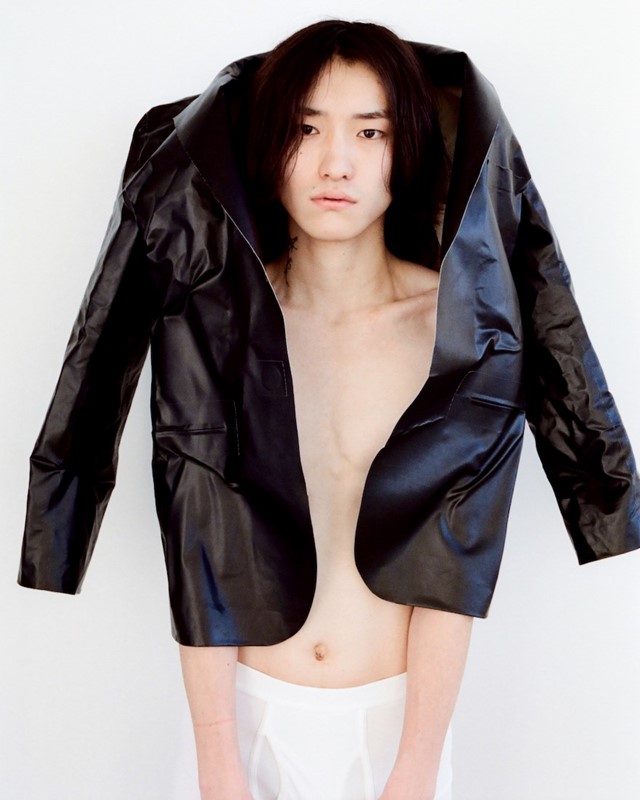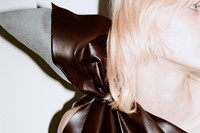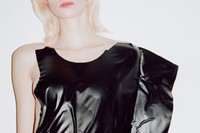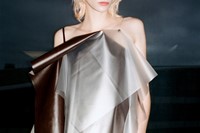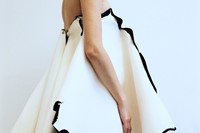Central Saint Martins students Freddy Coomes and Matt Empringham, who are currently interning at Loewe and JW Anderson, created their new collection in just ten days
It’s not easy to wear Freddy Coomes and Matt Empringham’s latest collection, but that’s not really the point. Of the 30 looks in total, 15 are now disassembled in one small box – some of them just two unsewn pieces of fabric, fastened together with a magnet. The duo are both fashion design students at Central Saint Martins in the midst of their placement years (an optional industry year between second and final year), and sit side by side on a Zoom call from their small studio in Angel. Like you’d expect from any forward-thinking 22-year-old designers with a taste of fashion’s churning machine, they’re aching to forge their own paths.
The two designers met during their foundation at the hallowed London university, having been serendipitously paired together for their first project, and have worked together since. It’s not unusual for two fashion designers to join forces, from collaborators of the past like Yves Saint Laurent and Pierre Bergé, to more contemporary examples like Vivienne Westwood and Andreas Kronthaler, and Laura and Deanna Fanning at Kiko Kostadinov. What is exceptional in the case of Freddy and Matt, is that they found one another at 18. “I guess we were just really lucky,” Freddy says with a smile.
Four years and five collections later, the duo are working apart for the first time, but under the same creative director, Jonathan Anderson; Freddy is living in Paris while interning at Loewe, and Matt at JW Anderson in London. The impression left by the designer is palpable. Anderson, an experimenter and innovator, has spent years transgressing boundaries with mischievous fashions that uphold exquisite values of craft, with a catalogue of ecstatic references that are practically second to none. Where Anderson dedicates an entire season to designing, curating, building and refining a collection, Freddy and Matt, amid their work placements, proliferated the looks in their collection across ten days over Christmas. “The whole time we’ve worked together, it really starts at the fabric,” says Freddy, “and then we find a garment within the fabric.”
One dress from the collection – a bundle of neoprene tubes strapped to a harness – has already been worn by Emma Corrin for a cover story in ES Magazine styled by Harry Lambert. “If they’d seen the shop where we bought that rubber from …” Matt laughs. Pulling together an array of materials, from latex and silk to adhesive leather and felt, Freddy and Matt hastily experimented on the body in playful drapes and imaginative fastenings; their budgets and time constraints mean each look merely is a blueprint, an essence of what could be a finished garment. Having been approached by publisher Ayvan to collate the lookbook into an immersive book, they pulled together a team of art directors, graphic designers, casting directors, and a writer, Robert Smith, who christened the book All Black Flexing Tour Bus ESC Key Filter System; A Blanket E-Scooter, and writes the equally verbose accompanying text.
Here, the duo discuss why they escaped the slow and cerebral pace of fashion design, and the importance of play.
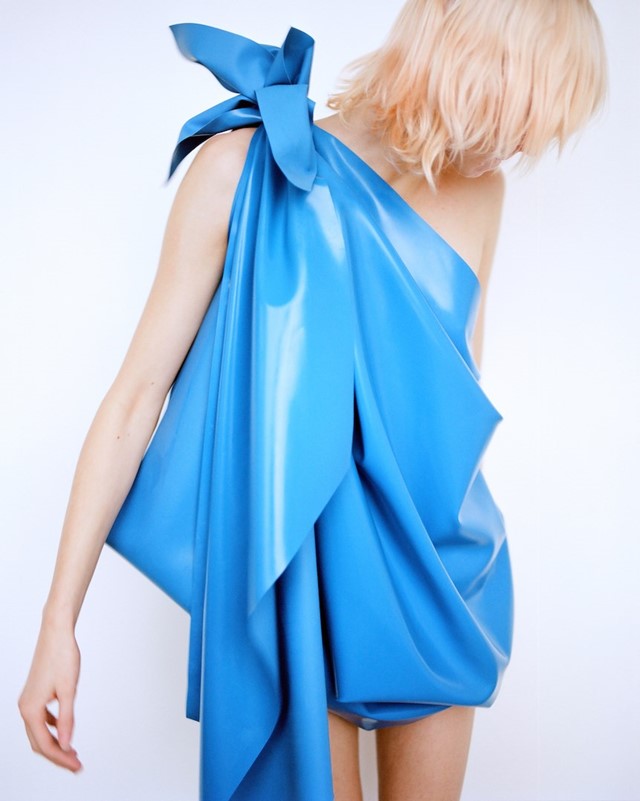
George Pistachio: What is it that makes you both work so well as a duo?
Matt Empringham: We’ve both definitely evolved in our own way over time, and it does feel like quite a large amount of time – three or four years – but I do think we have our differences, and we both bring different things to the table. But ultimately, we do share a very similar visual interest.
Freddy Coomes: It might even be like a button colour. It’s quite well aligned. And on a more practical basis – people don’t really speak about this enough – it’s incredibly useful to have someone that relies on you, and who you rely on, because you’re accountable. It’s nice to have someone to bounce ideas off of. If you say, ‘Yeah, I’m going to be there 10am,’ you actually kind of have to be there at 10am. You can’t roll in at 2pm.
ME: And through that you both develop way more than I would individually. And that’s not just a practical thing. I think that extends beyond just the clothes you make.
GP: What made you want to switch up your design approach for this project?
ME: We’ve both been exposed to working in these fashion brands, and I think we felt a real desire to step away from that classic approach to clothing and we really wanted to try things differently.
FC: And there’s a freedom that comes with not knowing exactly what it’s going to look like, and not toile-ing something and just throwing it on someone, and then seeing if it looks good. And if it doesn’t, then we change the idea. There’s something quite liberating about not being so structured in the way that you approach a garment. The way that the brands work is you’ll launch something with an atelier or a factory that will take weeks or sometimes even months to arrive and sample, and toile, and re-toile, and resample, and then change the fabric, and change the fit. This felt the complete opposite of that, it felt so instant and so accessible.
“The last bastion of rebellion is something that’s just really, really fucking nice, because it’s hard for people to be shocked anymore by something that’s offensive or revolting” – Freddy Coomes
[At work] I’ve been spending like two days talking about buttons, having conversations like ‘this should be like this,’ but ‘this is actually a bit too long’ and ‘we need to change that,’ and then ‘we take a centimetre off this.’ So we felt just like throwing a plastic sheet on someone – let’s try that.
GP: So in a way, was this collection rebelling against the labour-intensive approach to making clothes?
ME: It wasn’t so much about rebelling, it was more just trying to make something that felt inspiring, and something that people could really get into in an accessible way that didn’t have such incredible materials or huge budget. There’s a look made of some A4 paper that I think ‘nails-on-the-head’ what we’re trying to get out with the project. It’s very simple, but it’s gestural. You know where it's coming from, and you know where it could go.
GP: Did you intend on it being wearable?
ME: I think it could go there, but it deliberately hasn’t.
FC: Everything is quite purposefully a starting point for something else. The A4 paper could turn into quite a beautiful textile, and that could turn into quite a beautiful print, but where it is right here is really just more of a starting point to look at.
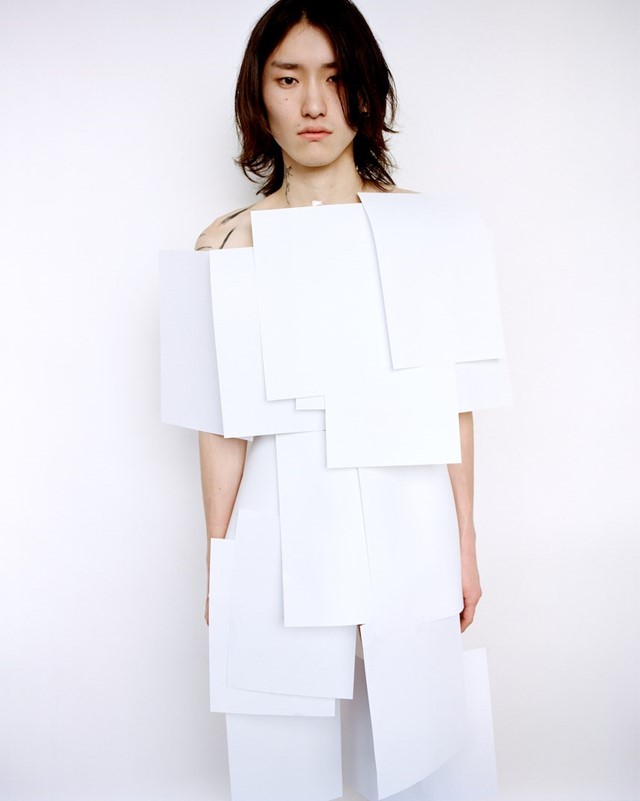
GP: There’s a real element of play, almost naivety within some pieces in the collection. Is that intentional?
ME: Naive is an interesting word because we are quite naive at our age, and to pretend that we’re not is wrong.
FC: I think the childishness isn’t something that we landed on intentionally. If that’s what comes across, I guess it is quite childish in the sense that we are just like making stuff quite fast and quite quickly, and just taking a picture of it.
ME: It’s nothing to be precious about.
GP: Were you aiming to make something beautiful?
FC: I think beauty is one of the only things that can still shock people. It’s almost like the last bastion of rebellion is something that’s just really, really fucking nice, because it’s hard for people to be shocked anymore by something that’s offensive or revolting. Beauty is at the heart of what we’re trying to do. If your idea of what a ‘beautiful thing’ is comes entirely from what other people think it is, it’s always going to be an imitation of what someone else wants to see.
ME: You’d essentially be a stylist.
FC: Or just a really shit designer.
All Black Flexing Tour Bus ESC Key Filter System; A Blanket E-Scooter is published by Ayvan and is out now.
